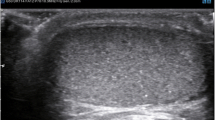Summary
Foci of extramedullary hematopoiesis were studied in testicles of 653 children 0–18 years old and their frequency were compared, paying special attention to age, degree of maturity, and diseases of the children. The intensity of the testicular hematopoiesis, expressed in number of hematopoietic cells/mm2, was calculated. Major illnesses or causes of death were taken into account in calculating the intensity.
Results showed that hematopoietic foci in testicles of children are frequent (26.5% of the cases), especially in the first three months of life (36% of the cases), but less in the fourth month and extremely rare after four months of age.
The foci of testicular hematopoiesis during the perinatal period must be regarded as a banal phenomenon. Although prematurity evidently does not influence the intensity and the frequency of the testicular hematopoiesis, infections, hypoxemia, anoxemia and blood diseases do stimulate them. Such conditions and illnesses are also responsible for the persistence of testicular extramedullary hematopoiesis during the first four months of life, a particular reaction of the very young infant. This reaction disappears in the older infant and child.
Zusammenfassung
An Schnittpräparaten der Hoden von 653 Kindern, die im Alter von 0–18 Jahren verstorben waren, wurde die Häufigkeit testiculärer Blutbildungsherde geprüft. Besondere Beachtung wurde den Beziehungen zu Alter, Grad der Reifung und eventueller Grundkrankheit der Kinder geschenkt. Um genauere Angaben über die Intensität der testiculären Hämatopoese zu erhalten, wurde die Zahl hämatopoetischer Zellen pro Quadratmillimeter Hodengewebe berechnet. Auch hier wurde die Abhängigkeit der gefundenen Werte von Alter, Reifungsgrad und Grundkrankheiten der Kinder kontrolliert.
Die Untersuchungen zeigen, daß hämatopoetische Herde im frühkindlichen Hodengewebe sehr häufig sind. Ohne Berücksichtigung des Alters findet man sie in 26,5% aller Fälle. Ganz besonders häufig sind sie in den ersten 3 Lebensmonaten, wo man sie in 36% aller Fälle nachweisen kann. Im 4. Monat nimmt ihre Häufigkeit bereits stark ab. Später sind sie ausgesprochen selten.
Blutbildungsherde müssen in der perinatalen Periode als relativ banaler Befund gewertet werden. Unreife an sich führt nicht zu einer Vermehrung der Blutbildungsherde, dagegen lösen Infektionen, hypoxämische Zustände und Blutkrankheiten eine deutliche Zunahme der Häufigkeit und gleichzeitig eine Intensivierung der testiculären Hämatopoese aus. Die gleichen Zustände und Krankheiten müssen auch für die Persistenz derartiger Blutbildungsherde bei Kindern von 2–4 Monaten verantwortlich gemacht werden. Hämatopoetische Herde sind auch im Hoden Ausdruck einer besonderen, möglicherweise z. T. sogar entzündlichen Reaktion des Säuglings, die beim älteren Kinde verschwindet.
Résumé
Des foyers d'hématopoièse extramédullaires ont été recherchés dans les testicules de 653 enfants de 0–18 ans et la fréquence de leur découverte a été comparée en fonction de l'âge, du degré de maturité et des maladies que présentaient ces enfants. L'intensité de l'hématopoièse testiculaire a été calculée en nombre de cellules hématopoiétiques par mm2 et les affections principales ou ayant causé la mort de l'enfant ont été étudiées en fonction de cette intensité.
Les résultats montrent que la découverte de foyers d'hématopoièse dans les testicules des enfants est fréquente (26,5% des cas) surtout pendant les 3 premiers mois de vie (36% des cas), plus rare dans le 4ème mois et enfin extrêmement rare à partir de 4 mois d'âge.
La découverte, dans une certaine mesure, de foyers d'hématopoièse testiculaire pendant la période périnatale est un phénomène banal. Par contre, si la prématurité n'influence pas, en elle-même, de façon sensible l'intensité et la fréquence de l'hématopoièse testiculaire, certains stimuli peuvent les augmenter (maladies infectieuses, hypoxie, anoxie, maladies sanguines). Ces stimuli sont également responsables de la persistance, durant les 4 premiers mois de vie, d'une hématopoièse extramédullaire testiculaire, qui représenterait alors un mode de réaction particulier du jeune nourrisson. Ce mode de réaction disparaît ensuite chez le nourrisson plus âgé et chez l'enfant.
Similar content being viewed by others
Bibliographie
Brannan, D.: Extramedullary hematopoiesis in Anemias. Bull. Johns Hopk. Hosp. 41, 104–118 (1927).
Gruber, G. B.: In: Handbuch der speziellen und pathologischen Anatomie (F. Henke — O. Lubarsch): Die Leber bei Erkrankungen der blut- und lymphbildenden Gewebs-Apparates. Bd. 5/1, S. 631–649. Berlin: Springer (1930).
Gusek, W.: Subendokardialer heterotoper Blutbildungsherd im Herzen einer Frühgeburt. Z. Kreisl.-Forsch. 46, 930–933 (1957).
Hempel, K. J., u. R. R. Heim: Über Rundzell- und Blutbildungsherde in Nebennieren. Zugleich ein Beitrag zur Frage der Entstehung von sogenannten Myelolipomen. Frankfurt. Z. Path. 76, 191–200 (1967).
Herzenberg, H.: Zur Frage der extramedullären Granulo- und Erythropoese. Beitr. path. Anat. 73, 55–63 (1925).
Jacobson, L. O., E. K. Marks, E. O. Gaston, and E. Goldwasser: Studies on erythropoiesis. Blood 14, 634–643 (1959).
Maximow, A.: In: Handbuch der mikroskopischen Anatomie des Menschen (W. v. Möllendorff), Bd. 2/1: Extramedulläre Myelopoese, S. 417–425; Embryonale Entwicklung des Blutes und Bindegewebes. S. 466–517. Berlin: Springer 1927.
Mita, G.: Physiologische und pathologische Veränderungen der menschlichen Keimdrüse von der fötalen bis zur Pubertätszeit, mit besonderer Berücksichtigung der Entwicklung. Beitr. path. Anat. 58, 605–609 (1914).
Naegeli, A.: Blutkrankheiten und Blutdiagnostik: Die embryonale Blutbildung, 5. Aufl., S. 102–104. Berlin: Springer 1931.
Plum, C. M.: Extramedullary blood production. Blood 4, 142–149 (1949).
Potter, E. L.: Pathology of the fetus and the infant, second ed., p. 621. Chicago: Year Book Medical Publishers. Inc. 1961.
Stulkowski, K.: Study on hematopoietic foci in the lungs of fetuses and newborn infants as a form of inflammatory reactions. Pozn. Towarzy Przyjac. Nauk, Wydz. lek. 34, 261–274 (1966).
Thoenes, W.: Über den Status der Erythropoese in der normalen Neugeborenenleber. Virchows Arch. path. Anat. 328, 220–238 (1956).
—— Fetale Erythroblastose und ihre Grenzfälle. Virchows Arch. path. Anat. 331, 371–381 (1958).
Zollinger, H.: Foetale Entzündung und heterotope Blutbildung. Schweiz. Z. Path. 8, 311–331 (1945).
—— Die pathologische Anatomie der Erythroblastose. Verh. dtsch. path. Ges. 40, 22–40 (1956).
Author information
Authors and Affiliations
Rights and permissions
About this article
Cite this article
Calame, A. L'hématopoièse testiculaire chez l'enfant. Virchows Arch. Abt. A Path. Anat. 347, 225–234 (1969). https://doi.org/10.1007/BF00543109
Received:
Issue Date:
DOI: https://doi.org/10.1007/BF00543109




